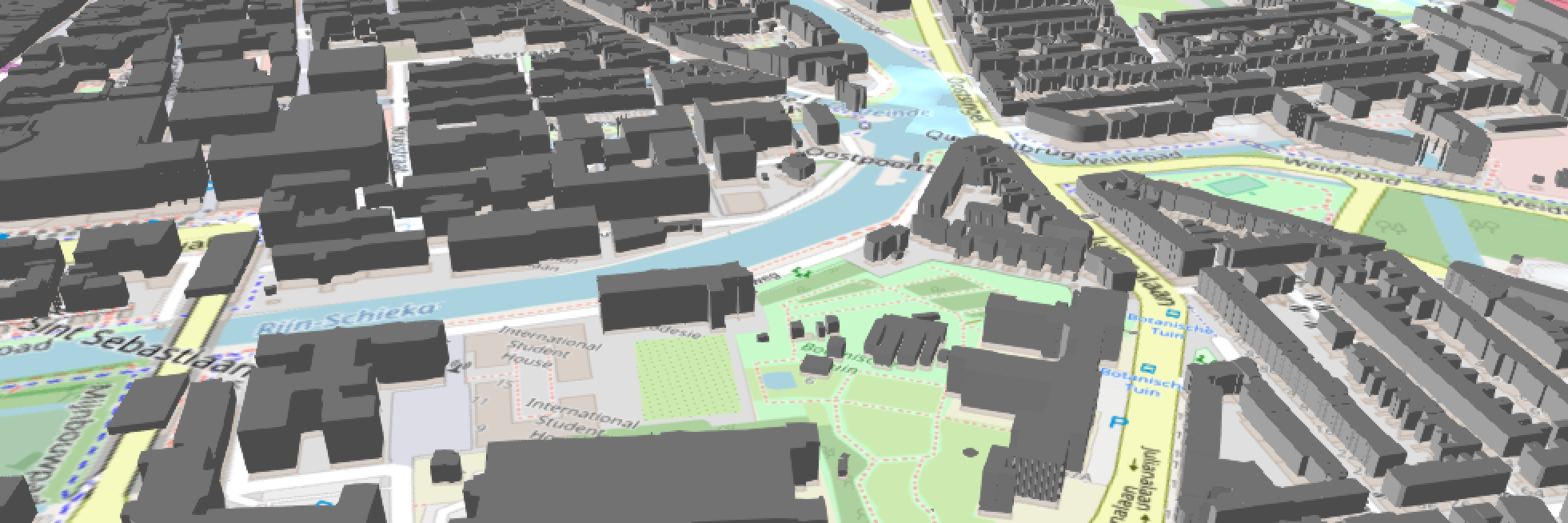A very basic and experimental converter from CityGML to Cesium 3D Tiles.
The purpose of this JavaScript code is to read CityGML files, extract objects (like buildings), and write the corresponding meshes as a batched 3D model in the 3D Tiles spec. Each building will become a feature, and its attributes will be stored in the 3D Tiles batch table. For more information see docs/background.md.
The code for writing 3D Tiles files is based on the 3D Tiles Samples Generator.
The functionality is very basic, and many limitations exist:
- Only city objects of type
Buildingare converted. - Textures are not converted.
- Only a single B3DM file is generated. (This works fine for small data sets, for larger sets probably a hierarchy of multiple files with different resolutions should be generated.)
- Files larger than 2GB cannot be converted because of the limits of NodeJS'
Buffer.
The library provides an executable to convert files on the command line.
- Make sure you have NodeJS version 13+ installed!
node --version
- Install the NPM package
npm install -g citygml-to-3dtiles
- Use the script to convert CityGML to 3D Tiles
citygml-to-3dtiles "my-citygml.xml" "my-output-folder/"
When converting large files, it can be necessary to increase NodeJS' memory limit. For example run the conversion with a 10GB memory limit:
NODE_OPTIONS=--max-old-space-size=10000 citygml-to-3dtiles "my-citygml.xml" "my-output-folder/"
Instead of a single input file the script also accepts a path to a folder containing multiple CityGML files. The contents of all files will get concatenated and written to a single 3D Tileset.
The library exposes an easy to use API to convert from CityGML to 3D Tiles. Using the library programmatically allows us to calculate custom properties and store them in the resulting tileset.
import Converter from "citygml-to-3dtiles";
let converter = new Converter();
await converter.convertFiles('./input.xml', './output/');By default any CityGML attributes and external references are stored in the 3D Tiles batch table.
Additional properties can be stored per feature by passing propertiesGetter.
The function propertiesGetter is executed once for each city object and the key/value pairs of the return value will become the model's properties.
The function receives two arguments:
-
cityObject: An instance of type
CityObject. Can be used to retrieve the object's geometry and to access the corresponding XML node from the CityGML. - properties: Key/value pairs of all the attributes and external references from the CityGML. Usually each building will have some kind of identifier assigned to it, which could be used to link the data to other data sets. That way we can blend in other tables of data referencing the same buildings.
Example: Get the value of an element <measuredHeight> in the XML namespace "bldg2" (http://www.opengis.net/citygml/building/2.0)
and store it as "measuredHeight" in the batch table:
let converter = new Converter({
propertiesGetter: (cityObject, properties) => {
let measuredHeightNode = cityObject.cityNode.selectNode('./bldg2:measuredHeight');
let measuredHeight = parseFloat(measuredHeightNode.textContent);
return {
measuredHeight: measuredHeight
}
}
});
await converter.convertFiles('./input.xml', './output/');Example: Store the convex surface area of each building (calculated from the geometry) in the property "surfaceArea":
let converter = new Converter({
propertiesGetter: (cityObject, properties) => {
let mesh = cityObject.getTriangleMesh();
return {
surfaceArea: mesh.getSurfaceArea()
}
}
});
await converter.convertFiles('./input.xml', './output/');Allows to remove city objects (buildings) based on a callback function.
The function specified receives the city object (CityObject) as its only argument and should return true or false to decide
whether to include it in the 3DTiles output.
Example: Only include objects with a maximum distance of 600m of a given point.
let center = Cesium.Cartesian3.fromDegrees(8.5177282, 47.3756023);
let converter = new Converter({
objectFilter: (cityObject) => {
let distance = Cesium.Cartesian3.distance(center, cityObject.getAnyPoint());
return distance < 600;
}
});
await converter.convertFiles('./input.xml', './output/');The coordinates in CityGML are defined in a certain spatial reference system (SRS). This script assumes that all coordinates in a document are using the same SRS. Height component of coordinates is not transformed according to the SRS, because the library used (proj4js) doesn't support it.
Only a few SRS are defined by default. Additional SRS can be passed to the converter:
let converter = new Converter({
srsProjections: {
'CH1903': '+proj=somerc +lat_0=46.95240555555556 +lon_0=7.439583333333333 +k_0=1 +x_0=600000 +y_0=200000 +ellps=bessel +towgs84=674.374,15.056,405.346,0,0,0,0 +units=m +no_defs',
}
});
await converter.convertFiles('./input.xml', './output/');
The definition should be in the "PROJ.4" format. Definitions in that format can be found at http://epsg.io/.
For Delft an area is available in CityGML2 LOD1 from TU Delft.

For Zürich a small area of LOD2 CityGML is available from Stadt Zürich, Geomatik Vermessung.
Here the buildings' hull volume is color coded in Cesium:

Install dependencies:
npm install
Run tests:
npm test
Release a new version:
- Check out the latest version
git checkout master && git pull --ff-only
- Bump version in
package.json, runnpm installand commit the change. - Push a new tag to master
git tag "vX.Y.Z"git push && git push --tags
- The Github-Actions CI will deploy to NPM

